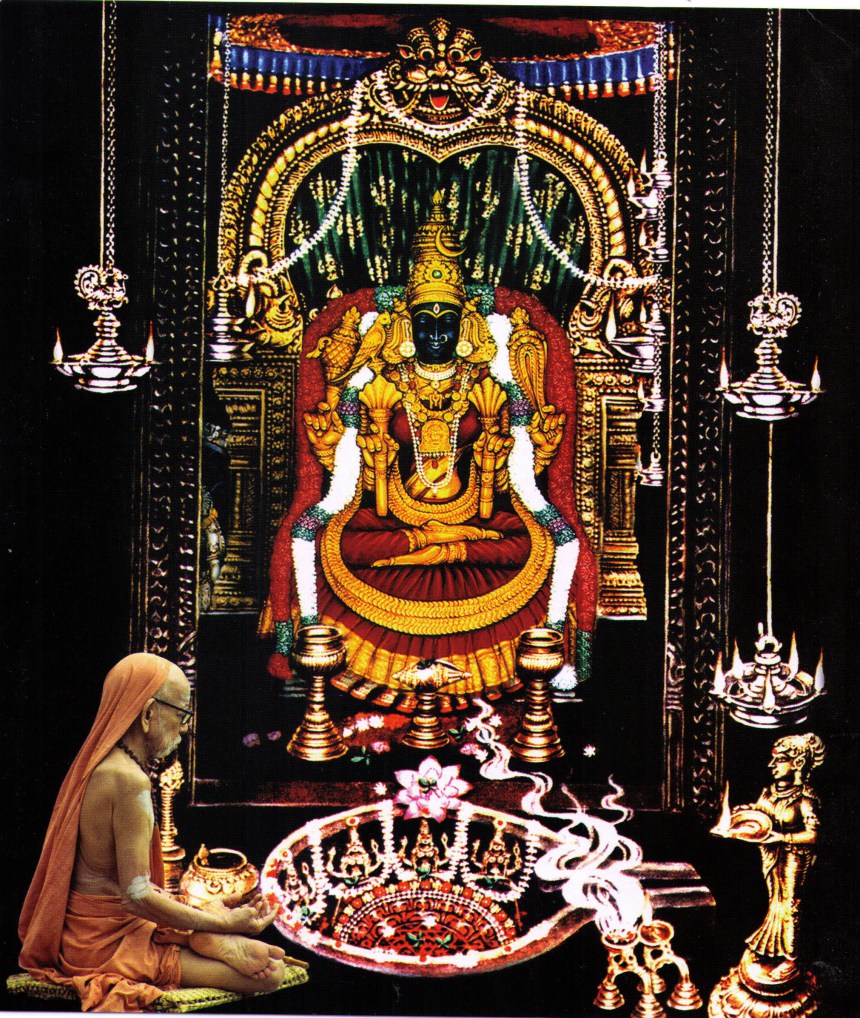His Holiness Jagadguru Poojyashri Chandrashekharendra Saraswathi Mahaswamigal
The 68th Shankaracharya: His Holiness Shri Chandrashekharendra Saraswathi Swamigal
Shri Swaminathan (born at Villupuram in Tamil Nadu on 20th May 1894 under the Anuradha Star) was taken to Kalavai in his 13th year, when he was studying at Tindivanam (Tamil Nadu), to be initiated into ascetic order and ordained as the 68th Shankaracharya of the Kanchi Kamakoti Peetham. He was given the Sanyasa name Shri Chandrashekharendra Saraswathi. He was affectionately called by many names "Mahaswamigal" (the Great Lord), "Mahaperiyavaal" (The Great Elder) and Nadamaadum Deivam or Nadiche Devudu (the God Wlking Among Us).
He adorned the Peetham from February 13, 1907. True to the tradition of the Peetham set by Adi Shankara Bhagavadpada, Mahaswamigal travelled throughout the country by foot or by the traditional palanquin. He also stood by the national sentiments in discarding "foreign cloth" (He immersed them in water instead of consigning them to flames) and started wearing cloth made of Khadi. He set the trend to create Trusts for achieving the objectives of the Peetham.
His foremost concern was preservation of the Vedas, traditions and Dharma. He advocated simplicity, and shunned pomp, ostentation and extravagance. His exposition of Vedanta, Shastras and the Dharmic duties attracted scholars and laymen alike, from far and wide, for his words were always rich in values and simple to understand. He had the keen acumen to relate root words of all the languages to Sanskrit highlighting its greatness and ancient nature. He returned to His Celestial Abode from Kanchipuram on 8th January 1994 (Dhanur, Krishna Dwadashi) in his Centenary year (Source: kamakoti.org).
Although the Mahaswamigal's life is a boundless ocean that can only be described completely by Himself, one may learn more about this great soul by watching the documentary "Sage of Kanchi."
Voice of God - Discourses of the Paramacharya
It is believed that, true to being the Pontiff of the Sarvajna Peetham (the Seat of Universal Knowledge), there was no topic the Paramacharya could not address. He would speak at the highest level of Vedanta but also give cooking instructions for improvement to a lifetime cook. He would talk to nuclear scientists and particle physicists on their own plane of understanding and constantly draw parallels to the same sciences as explained in the Veda's. He would recall minute incidents and people he had met five decades ago with superhuman intelligence and spontaneity. Though these may sound incredible, only those who have experienced these marvelous Leela's of the Paramacharya, without a doubt, would recognize Him as Kailashapathi Shri Parameshvara Himself, Vaikunthapathi Shriman Narayana Himself, and the Mother of the Universe, Shri Kamakshi Devi Herself. Yet, he would constantly feign aloofness and pose as a mere devotee of God.
The topics that the Paramacharya spoke of, in his discourses (Upanyasams), are numerous: indeed so vast that one could have been with him during all moments of his divine life and yet, not encompass them all. Nevertheless, devotees have compiled a small portion of the Paramacharya's discourses, starting 1932, and released them as a seven-volumed series called "Deivathin Kural" or "Voice of God." For those who found even this compressed form of his Upanyasam's voluminous (each book was about thousand pages), devotees compressed the Acharya's talks even further to bring out their very essence - the creme de la creme, in a single book: Hindu Dharma. We post here all chapters of the Hindu Dharma with the fond hope that everyone interested utilizes them to learn more about our great heritage and, indeed, rediscover it.
In fact, most of your Dharma-related questions will be addressed by:
Click here for:
Hindu Dharma - A Collection of Discourses by the Paramacharya
(Credit to Shri Ravi of BITS Pilani Students for the Mahaswami's Cause for making this electronic version available)
Protection and Revival of Vedic Dharma - Shri Rajagopala Ghanapaathin Speaks
यदा यदा हि धर्मस्य ग्लानिर्भवति भारत ।
अभ्युत्थानमधर्मस्य तदात्मानं सृजाम्यहम् ॥४-७॥
परित्राणाय साधूनां विनाशाय च दुष्कृताम् ।
धर्मसंस्थापनार्थाय सम्भवामि युगे युगे ॥४-८॥
"Whenever and wherever there is a decline in religious practice, O descendant of Bharata, and a predominant rise of irreligion—at that time I descend Myself." - Lord Shri Krishna
Shri Rajagopala Ghanapaathin eloquently describes, at the Rathnagirishvarar Temple Sadas (Vedic conference) the importance of Vedic Dharma, its dismal state in the nineteenth and early twentieth centuries and how the Paramacharya incarnated as its savior:
Does Vedic Dharma consist solely of the Veda's, Vedanga's etc.? No indeed! For the arts too form a critical part of Vedic Dharma. One may have gaped in marvel on entering huge temples, built of solid granite, and with impeccable architecture, in South India. Little do we know that temple architecture is based on the science known as Shilpa Shastra (The Science of Sculpting).
The inimitable Padmashri Muthiah Sthapathi and Shri Chandrashekhara Sthapathi, below, describe the ancient science of Vedic architecture and the patronage the Paramacharya provided for the same:
Shri Muthiah Sthapathi
Shri Chandrashekhara Sthapathi





